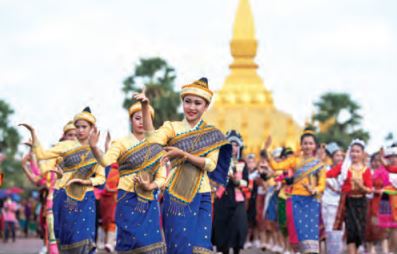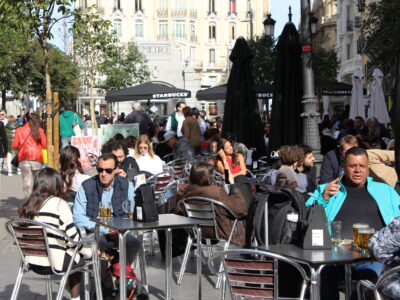
(Clockwise from L-R) Golden Pagoda of Phra That Luang Temple; Pha That Luang Festival; Wat Xieng Thong; Ock Pop Tok’s crafts workshop in Luang Prabang; Wat Xieng Khuan, A tour of Vientiane is incomplete without the sculptures in Buddha Park; 5th century Khmer ruins of Wat Phou is the second Laotian site in the UNESCO World Heritage list
Curious and enchanting, Laos is a destination unlike any other; a land of untouched wonder and rare beauty where time loses meaning and simplicity prevails. Rich in history and traditions, with diverse landscapes and varied heritage, it captivates the explorer, keen to continue the discovery further and deeper into the unknown.
Overshadowed and landlocked by its bigger neighbours like China, Thailand, Myanmar, Cambodia and Vietnam, Laos is a country rich in natural beauty, architectural heritage and untapped tourism footprints. The country’s intangible as well as tangible heritage is unique and for those Indians looking for new offbeat experiences, it is a destination worth a visit.
Reaching Laos is easier for the Indians as visa can be obtained electronically and popular international airports like Bangkok or Singapore are very well connected with the capital city of Vientiane and other important cities.
“From the rolling mountains of the north to the river islands of the south, our country embraces the visitor in a uniquely laidback lifestyle and the heartfelt generosity of our people. Regardless of travel pace and purpose, the Laos experience never fails to satisfy one’s curiosity – and delivers so much more. That’s our heritage,” says Sounh Manivong, director-general of tourism marketing department, Ministry of Information, Culture & Tourism, Lao People’s Democratic Republic.
Even in the present day, the country’s history continues to be excavated regularly, with thousands of year old copper drums and skeletons being unearthed and as a result, Laos is becoming a buzzing epicentre of South East Asian archaeological research. From ancient stone henge-style Hintang Standing Stones in the northeast and hundreds of massive rock vessels, scattered across the Plain of Jars in the central regions, to multiple stashes of massive Buddha-statue collections in caves and the Khmer temple complex of Wat Phou in the south, an archaeology enthusiast or a heritage lover is spoilt for choice.
The more recent history of the country dates from the Vietnam-era war, which saw Laos becoming the most bombed nation on earth, in the form of war remnants and compelling stories, with the Vieng Xay Cave complex in the far north-east.
Laos is one of the most ethnically diverse countries in the region with many of its heritage still living on. Ancient Theravada Buddhist practices are still alive well in the daily life across Laos, though they have waned in the neighbouring countries.
Artisans are at the heart of Laos. They are engaged in mainly three types of work – weaving and stitching; basketware; and metalwork. A variety of half or full-day trips are available and for a slower experience, homestays and other accommodation arrangements are also available. Almost every Lao ethnic group has its own silk or cottonproduction traditions and techniques dating back to the distant past. The sustainable, renewable resource of using bamboo to prepare basketware has long been used, with intriguing nuances in pattern varying by region. Recent archaeological finds are proof of Laos’ royal traditions of silver, gold and copper mining, casting and hand-engraving traditions & skills.
“I was in Luang Prabang for a few days last year and on the last day, I went to the Kuang Si Falls and the Butterfly Park next door. On my way back to the city, I stopped at a lovely little village where a community of Hmongs live. They are one of the ethnic communities of Laos and they are not to be confused with Lao – the people of Laos. They migrated from China and lived in Laos and some of them eventually migrated to the U.S. after the Vietnam War as it’s believed that they sided with the Americans. Some of the Hmongs still live in Laos. They have a unique dialect – actually, two, called White and Green and it is based on the colour, design, and pattern of the clothes worn by the people. However, they say that it’s not strictly followed today. It is said that they didn’t even have a written language until the 1950s and they communicated orally and through ‘Story Clothes’. The tour, a bit of a tourist trap lasted for barely 20 minutes as you meet little girls dressed up in their traditional costumes and they invite the tourists and request to buy their handmade dolls and bags. But the lovely children are so charming that you don’t mind the requests,’’ Lakshmi Sharath, one of India’s leading travel bloggers tells India Outbound.

Pi Mai Festival (Lao New Year) is celebrated in mid April
Laos is not a mass-market package tour destination. Nor is it the cheapest destination in South East Asia. It is a destination for curious explorers, many of whom have already been on SE Asia tours and are returning for a more engaged, authentic experience.
“Laos is not just Thailand’s country cousin or Vietnam’s little sibling. It offers a unique mix of assets found very rare in places. Unlike those noisy frenetic neighbours with their fast-paced lifestyles and cramit-all-in itineraries, Laos is a peaceful and laidback country that offers tourists a restful place for authentic experiences, rather than a long list of sights to tick off. It is a place for travellers who want to tick mark their bucket list from the history book,” says Manav Soni, CEO of Exclusive Travels, a Kolkata-based outbound tour operator.
With a history going back more than 70,000 years, many types of builders have left their legacy in Laos. From ancient religious sites to French colonial quarters and quirky modern makers, there’s something for everyone to discover a piece of the legend.
The Fantastic Four
LUANG PRABANG

LUANG PRABANG
Perhaps the best known destination in Laos, this former royal capital is a UNESCO world heritage site for its east-meetswest character which merges scenes of traditional Buddhism and ethnic minority ways of life with French colonial architecture
CHAMPASAK & SI PHAN DON

CHAMPASAK & SI PHAN DON
The site of Angkorera civilisation and kingdoms in the province of Wat Phu, a ruined Khmer Hindu temple complex, also the Bolavan Plateau with multiple waterfalls, and the Siphandon or 4,000 islands that form Laos’s southern Mekong border with Cambodia
PLAIN OF JARS

CHAMPASAK & SI PHAN DON
Best known for the myriad giant stone jars of ancient origin scattered liberally over a vast hilly area, this province was heavily bombed during the Vietnamera ‘Secret War’ and is pockmarked with the scars of UXO (unexploded ordinance)
THE LOOP

THE LOOP
Konglor, a 7-km underground river cave system with stalactites along with a 450-km circular route of 30 natural and cultural attractions is a popular bike route easily accessed from Thailand’s Nakon Phanom via Friendship Bridge #3






















